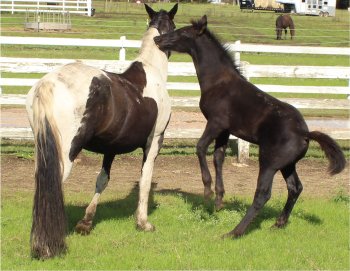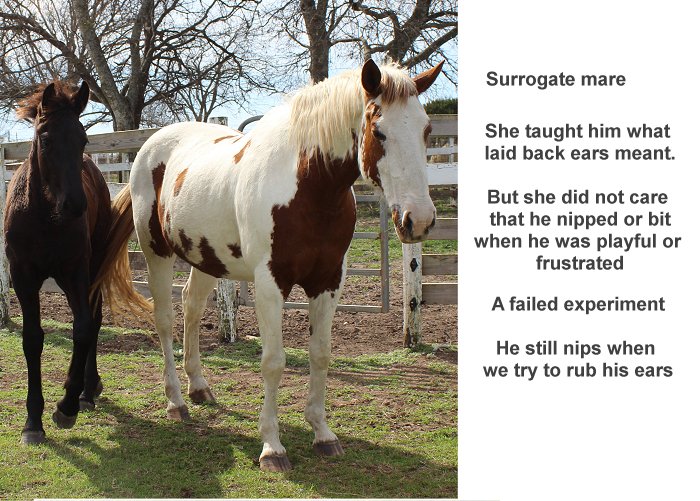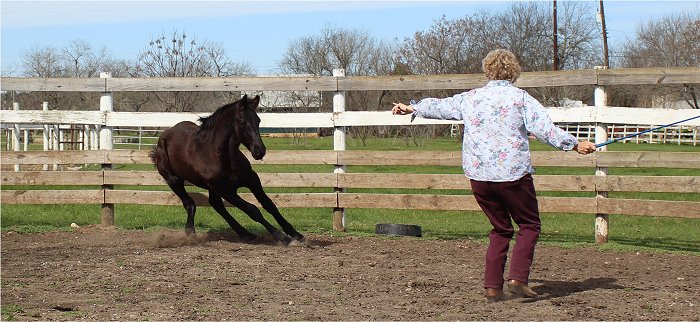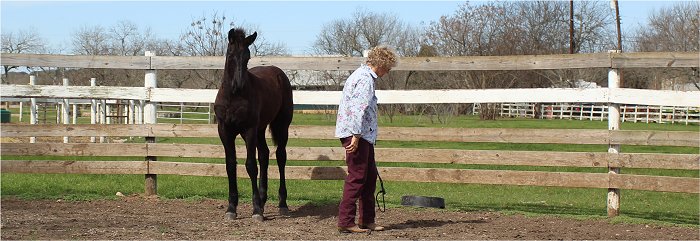A Tale of Respect That Conquers All
Young horses go through stages of “mouthiness”. They start biting for a couple of reasons:
1. Baby horses, like baby humans, explore the world through taste. Putting their mouths and teeth on things gives them feedback about its composition and personality.
2. Young horses incorporate biting into their gymnastics naturally, and the foal may want to play. With no outlet but you, you become the target of the game.
3. They are afraid and biting in self defense.
4. They are developing a dominant personality (as in stud colts particularly but all foals in general) and are trying to dominate the person receiving the bite
Although our 4 month old colt is not yet to the point where we can put a halter on him easily when he is loose in the pasture, he has become much more friendly. We go out to talk to him frequently and make every effort to rub and pet him. When we enter the pasture, he is very curious and approaches us easily. However, given a chance, he wants to explore all over us, and frequently begins to mouth our clothes and then nip us.
 This is behavior that needs to be discouraged.
This is behavior that needs to be discouraged.
He is getting larger. He tolerates and even seems to enjoy a sort of hug around his neck, but he turns his head to bite when we are standing at his side rubbing him or as we try to rub his head. Pushing his head forcefully away (picture left) has the potential to invite him to engage in nipping play or worse. He becomes more determined – pushing back and even showing his teeth.
“Tasting” everything is very natural for colt shenanigans but cannot continue into “objection” nipping – particularly as this is a little stud colt who can easily start with play-nipping and launch right into dominance biting.
Possible Solutions
Pulling a whisker is uncomfortable. Other trainers have offered this suggestion. If you are able to pull a whisker each time he bites, he will soon learn that biting leads to discomfort. You must be able to do it surreptitiously, without fanfare and with perfect timing. In the case of our colt, there is really no time to grab a whisker before he can nip your forearm painfully. I’m not sure how well this routine will work in other situations.
Another mare in the pasture
 In the case of this colt, his dam (half-friesian, black & white) is as passive as they come. He shares a 3 acre paddock with just her, and she allows him to rear up and place his front feet on her haunches, bite her and generally disrespect her in every way. She has not really given him any manners at all.
In the case of this colt, his dam (half-friesian, black & white) is as passive as they come. He shares a 3 acre paddock with just her, and she allows him to rear up and place his front feet on her haunches, bite her and generally disrespect her in every way. She has not really given him any manners at all.
If your mare is familiar with other horses at the ranch, another mare in her pasture may teach the colt some manners when he tries to bite. The dam will not let another mare hurt the colt, but she will usually not interfere in just general herd dynamics. Scrimshaw was drafted as Nanny in Chief.
However, in this case, the experiment failed. Scrimshaw did not care if he also bit her in his playful and experimental style. She was as tolerant as his dam.

Let’s go back to some basic Natural Horsemanship reasoning.
 Although he is barely 5 mos old, he is large. I cannot get a halter on him because of the biting issue. I want to be able to control him before I try any type of biting discipline that might turn bad. I decided to start with using the round pen for halter-breaking him. He needs to learn some respect and some control free of hands.
Although he is barely 5 mos old, he is large. I cannot get a halter on him because of the biting issue. I want to be able to control him before I try any type of biting discipline that might turn bad. I decided to start with using the round pen for halter-breaking him. He needs to learn some respect and some control free of hands.
 Round-penning is the basis for learning that “stop” is the answer to ending fearful pressure as well as giving respect to the handler. I’m older than I used to be, and he is bigger than he should be, but we accomplished his “stop and face” in a short amount of time. That left my approach and mounting the halter. Still no easy task, since I still had to get past the high-headed-nipping threat.
Round-penning is the basis for learning that “stop” is the answer to ending fearful pressure as well as giving respect to the handler. I’m older than I used to be, and he is bigger than he should be, but we accomplished his “stop and face” in a short amount of time. That left my approach and mounting the halter. Still no easy task, since I still had to get past the high-headed-nipping threat.
Then something radical happened. He got into a thicket that turned out to have barbed wire in it and sustained a gash on his rump. Now it became imperative that we get our hands on him and halter him IMMEDIATELY so the vet could take a look.
Danielle to the rescue.
She approached him after his “stand and face”, sidled up to “hug” him with the halter in her hand.
As he tolerated the hug, and when he did not expect it, she passed the halter rope under his neck and over his poll, then hung on for dear life as he took off like a wild horse. He dragged her all of the way around the round pen, one full circle, and she never let go until he stopped. It was a wild and crazy ride.
But it actually followed the rules of natural training – although a little dramatically. Because she was able to hold on to him to the end, he finally applied his “stop” to the fear (pressure) of dragging her around on his head.
Step one: He was frightened and began to run.
Rule 1: She went “with” him until he stopped. As our lesson progresses, this is an important rule. When we desensitize a horse we go “with” him until he stops, then the pressure is ended.
Timing: At the point where he stopped running, the pressure was lightened and quickly released as the halter was tied.
Success: He remembered the round-pen “stop” exercise and applied it. It worked. The pressure was released.
The Risk: This could have turned out badly. Had she turned loose while he was still running, it could have been a disastrous lesson. He would have learned just the opposite: Run and you can end the pressure.
I wish I had a video of the event. It was a dramatic “cowboy way”, and not what I would recommend as a way to halter-break a colt. But “all’s well that ends well”.
But that’s not the end of the story. We’re here to talk about biting.
You guessed it. That dramatic moment when the colt ceded respect from colt to human solved the biting issue! We are no longer his underlings, playthings, or equals but his benevolent masters. Mission accomplished. He has not even tried to bite since that moment desite the fact that he has had to have his wound irrigated and treated every day. He’s not exactly happy about the procedure, but biting has not entered the picture.
Obviously, I am not recommending that you wrestle your horse to the ground to stop the biting. What I am proposing is that you go back to some very basic “respect” lunging and other respect exercise. Do them hard and frequently until he realizes that you are master and he is lower in the pecking order of the herd.
Horse training can be dangerous. Not all methods work on all horses. Instruction presented here is not meant to be prescriptive in nature, and Horse-Pros.com takes no responsibility for the welfare of any animal or person using our methods.
Please note that any advice given on horse-pros.com is neither veterinary nor prescriptive in nature but offered only as an introduction to this topic.
We need your help. We certainly don’t know everything. Please share your expertise and experiences. Comment on what is already written or Suggest a Category and Educate us about it. Grow Horse-Pros.com

When I touched his tongue with the hot potato he did absolutely nothing. I just kept holding it there until he finally backed away. I petted him and as soon as he reached around to push me I put it back on his tongue. Eventually I tried to just put it in his mouth. Finally he just stood quietly beside me and did not stick out his tongue. This may just really work. I will continue to do this each day and see how it goes. A great big thank you.
Hi again:
I am anxious to hear if this routine has worked over time. And did you try the lemon on his tongue? It has occurred to me that you don’t want to force the potato into his mouth, as eventually you want to put a bit there. We don’t want him learning to fight having something placed in his mouth. It is a fine line between “don’t put your tongue out or knock me with your head” and making him reject your manipulating his face and mouth.
Let me know how things are going.
Thank you so much for replying. He has never been given treats by hand. My husband would never allow me to give any of my horses treats by hand only in the feed bucket. So that has not been an issue. I will try the hot potato and let you know how that goes.
I really like this colt but this tongue thing has really been frustrating.
If he hates the hot potato, do this exercise about 10 times in a day. Every time you come into the barn, give him the treatment if he sticks his tongue out. Rub his cheeks if he does not.
If you can think of something with a TERRIBLE taste, that might also work. I don’t know if horses like straight lemon. I’ve never thought of trying it. It would be a lot more convenient to carry a lemon than a hot potato. Use your imagination to make his tongue behavior very unpleasant. We want him to say, “OMG here she comes. I hope she doesn’t put THAT on my tongue.”
Someone in the barn decided it was cute when my 2 year old stud colt stuck his tongue out to rub his tongue. Now if you do not rub his tongue he tries to bite or knock you with his head. He immediately clamps down on his tongue and insists that you touch it as soon as anyone approaches him. I am able to get a halter on him but it is difficult at times. Do you have any suggestions?
Hi DJ:
A couple of things occur to me immediately:
Whatever happens NO ONE can ever again allow this behavior. I think I would also quit giving any oral rewards at all until this behavior is gone. No treats.
Extinguishing the behavior can be difficult but not impossible. It needs to NEVER be reinforced again. AND/OR it should garner some type of negative stimulation. Read about reinforcement theory here:
http://horse-pros.com/5486/training-theory-reinforcement-theory
Maybe a hot potato? Sounds funny, but might work. Next time he sticks his tongue out, offer him the firm touch of a hot potato. Obviously, don’t damage him, but make it unpleasant. He will probably throw his head up and back away. You can then offer to rub his cheeks or face so that he knows it was not your hands that he should worry about.
Have time to do this without haltering him. That is not the important part and should not be part of the extinguishing exercise. Just “hot potato” then “comforting” hands.
If more ideas occur to me, I will add to this post.